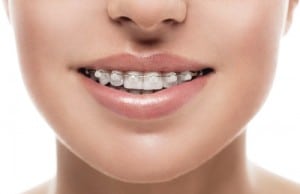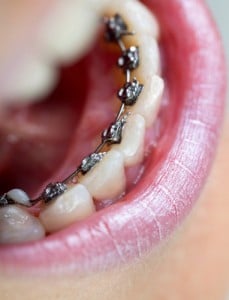If the idea of orthodontic treatment makes you feel a little self-conscious, you are not alone. Many patients are concerned about their appearances during orthodontic treatment, especially older teenagers and adults—especially professionals in the public eye.
Metal braces are most common due to their efficacy and lower costs. However, if that is what is holding you back from correcting your smile, there are alternatives. Consider these less “flashy” options that orthodontists can use to straighten your teeth.
Ceramics

However, ceramics are more expensive than traditional braces. They are also more prone to breaking, as they are composed of a more fragile material. To compensate for the brittleness, the brackets attached to your teeth are larger. The greater friction of the wire against the ceramic can also slow down your treatment times.
Plastics
Plastic brackets are composed of fiberglass-reinforced polycarbonate (with metal slots), and are clear colored, making all but the archwire mostly invisible.
Polycarbonate braces can sometimes discolor over time depending on diet and habits. Unlike metal brackets, which are cemented to the teeth, plastic brackets connect directly to the archwires and can be easily replaced.
Like ceramic braces, the friction index between the bracket and the wire is also high, which can mean extended treatment times.
Removable Braces
Made from polypropylene, these retainer-style plastic trays (known as aligners) are molded to fit over the teeth, with the most popular brand being Invisalign®. Plastic aligners resemble retainers or mouthguards, and are easily removable for eating and brushing. Otherwise, you wear the aligner continuously.
Aligners require a series of visits to the orthodontist, as about every two weeks they are removed and replaced to progress toward results. They are not as effective in complex orthodontic procedures and for certain malocclusions.
Lingual Braces

To create lingual braces, the orthodontist will take a mold of the teeth and then customize each bracket to fit a specific tooth. This process takes about six weeks. After that, a cementing process attaches the brackets to the back of your teeth.
Lingual braces are the least-conspicuous braces that offer full-scale orthodontic treatment. They are more effective than plastic trays, and can correct complex problems like the rotation and height of your teeth, as well as overcrowding or spacing.
Because they’re custom made, they cost a bit more and treatment tends to be more involved. Each tooth has its own installment of brackets and archwires, which can add up to totals greater than $5,000.
Lingual braces may also irritate the tongue and may cause it to become tender. Using wax against the lower teeth to cover the braces can help alleviate this soreness. Some people find speaking clearly and enunciating more difficult while wearing lingual braces.
Veneers
Dental veneers are thin, custom-made shells of tooth-like material designed to cover the front surface of the teeth. The most common veneers are porcelain, which resist stains and have the appearance of natural teeth.
Veneers are routinely used to fix teeth that are discolored, worn down or irregularly shaped. However, their convenience has made them a popular alternative to orthodontic treatment. But be aware that to apply veneers, the dentist will have to scrape away some of your healthy enamel.
Veneers offer relatively instant gratification, as the dentist can construct and apply them in just a few office visits. Subsequently, they don’t require any special aftercare—although continuing good hygiene habits is important.
Dental veneers can be quite pricey, with typical costs above $1,000 per tooth. To get the even look and spacing that orthodontic work achieves, you likely will need veneers on almost all your teeth.
Dental Bonding
Dental bonding is the application of tooth-colored resin (a durable, plastic material) to the tooth, using adhesives and high-intensity light. This material applied to the tooth improves appearance and spacing of the teeth, and can be an alternative to traditional orthodontic treatment in some cases.
After the material is hardened, your dentist will shape and polish it to match the tooth’s surface. Like veneers, bonding is easy to perform and typically is achievable in one or two office visits. However, it only is appropriate for minor cosmetic changes. If you have significant issues with your alignment or bite, bonding won’t do the trick.
Advantages and Disadvantages of Braces Types
|
TYPE |
PROS |
CONS |
| Metal Braces |
|
|
| Ceramic Braces |
|
|
| Plastic Braces |
|
|
| Removable Braces |
|
|
| Lingual Braces |
|
|
| Dental Veneers |
|
|
| Dental Bonding |
|
|
Orthodontic Associates offers a wide range of braces to accommodate the needs as well as the particular tastes of our patients. Choose from an office in Catonsville, Bowie, Fullerton, Owings Mills, Severna Park, Glen Burnie, Bel Air, Laurel or Columbia, and contact one of our friendly staff members to set up a complimentary consult. We look forward to making you smile!



